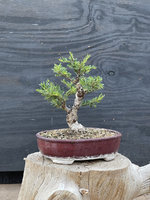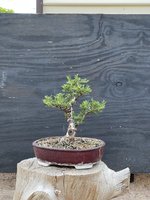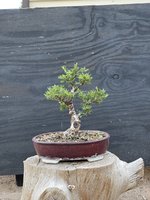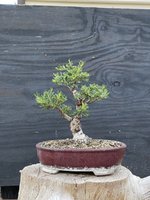Hartinez
Masterpiece
This is a bit of a continuation from another thread i started. This one
The roots Had obviously grown very well since this tree was started but so many were thick and lacked the fine roots need for long term development. I was pretty aggressive at repot. Lowered the soil level by about an inch and increased the flare considerably. Surface roots need work though.


My next step is to deal with a cut back and how much i want to cut back to. Some may say to just build branches from what’s existing but there are far too many long straight sections of trunk and i feel the sooner i cut back the better. After hearing from so many from the above thread, i will embrace the lumps and use them to my advantage. Here are the ideas I’m considering.
1. air layer several sections off this tree with the intention of reducing the tree to a single line that is only 5-6” tall, building a new trunk line and eventual side branches. @Shibui and @Bonsai Nut had mentioned that this cultivar does not throw long shoots they way other elms may making it difficult to add considerable girth to the trunk. My thought would be to keep the tree shohim sized, taking advantage of the small leaves. Making a finished tree height of 10-12”. Down side to this idea i suppose, would be the lack of natural form this path would lead me to. Do i want an elm styled as a black pine?

2. Air layer or just chop the trunks just past the straight sections leaving several trunks to build a new tree form. This design would still take advantage of the smaller leaves in making a smaller tree, but would utilize several trunks with branches growing up then out, rather than perpendicular to a single trunk line. Finish height would be 12-14”.

Here is another angle and a pic with out marks if anyone has a suggestion


The roots Had obviously grown very well since this tree was started but so many were thick and lacked the fine roots need for long term development. I was pretty aggressive at repot. Lowered the soil level by about an inch and increased the flare considerably. Surface roots need work though.


My next step is to deal with a cut back and how much i want to cut back to. Some may say to just build branches from what’s existing but there are far too many long straight sections of trunk and i feel the sooner i cut back the better. After hearing from so many from the above thread, i will embrace the lumps and use them to my advantage. Here are the ideas I’m considering.
1. air layer several sections off this tree with the intention of reducing the tree to a single line that is only 5-6” tall, building a new trunk line and eventual side branches. @Shibui and @Bonsai Nut had mentioned that this cultivar does not throw long shoots they way other elms may making it difficult to add considerable girth to the trunk. My thought would be to keep the tree shohim sized, taking advantage of the small leaves. Making a finished tree height of 10-12”. Down side to this idea i suppose, would be the lack of natural form this path would lead me to. Do i want an elm styled as a black pine?

2. Air layer or just chop the trunks just past the straight sections leaving several trunks to build a new tree form. This design would still take advantage of the smaller leaves in making a smaller tree, but would utilize several trunks with branches growing up then out, rather than perpendicular to a single trunk line. Finish height would be 12-14”.

Here is another angle and a pic with out marks if anyone has a suggestion







 DSC_3021
DSC_3021







